Thanks, again, to Sarah for putting together this fantastic, information packed series! I know that I learned a lot about what goes into preparing for a show, and hopefully many of you did, too. For future reference, all of the posts in this series can be found under the “Prepping for the Show” category.
Category Archives: Prepping for the Show Series
Prepping for the Show : After the Show
We definitely took a few days off after the show to just relax and not think about anything stationery related.
Once we started back up, the first thing we did was to transfer all of the business cards we had collected throughout the show into our Outlook contacts. We just did this the old school way, manually typing all of the information. They did have badge scanners available at the show, but they were too expensive for us this time around. We also looked into business card scanners, but this was also a little too expensive. We collected about a hundred business cards, so for us it wasn’t too time consuming to just type them in. Plus, this also allowed me to go through each and every person who had visited our booth, and put them into different groups like “requires immediate follow up”, “sample request”, etc.
The next thing we did was focus on getting our orders out. It’s funny that the whole point of going to the show is to get orders, but there are so many other things going on that you almost forget about that aspect of it. You forget that you now actually have to pack and ship the orders you did receive. We thought we had a good system set up for packing and shipping, but you really don’t know how well something is going to work until you’re in the middle of it. Let’s just say don’t order too many of one size box only to realize it’s the wrong size. I think we’re now one of Uline’s top customers for the number and variety of cardboard boxes we ordered from them the week after the show.
I think it’s important to have clear shipping guidelines in the terms/policies section of your order form. We promised a ship date of 2-3 weeks from the order date, which was more than enough time for us to get our orders out. I think it’s always better to under-promise and over-deliver, than to over-promise and under-deliver.
We heard from some veteran exhibitors and from the show organizers that a lot of orders are placed within the two weeks after the show. We did get a few orders the first week after the show, but it’s slowed down since then.
Once all of our orders were shipped, the next item on our to-do list was sending samples to members of the press and stores that had visited our booth and had requested specific items.
We’re now in the follow-up phase, and over the next few months we plan on making appointments with local stores and contacting the stores that visited our booth, but that didn’t place an opening order at the show. We’re also working on getting the e-commerce part of our website up, www.sarahmarie.com, and we hope to have that done by the end of July/beginning of August. For now, all of our products can be purchased through our Etsy store, www.sarahmariedesigns.etsy.com.
Overall, exhibiting at the show was a great experience. It has always been one of my dreams to design a line of stationery and gift wrap, and to exhibit at the National Stationery Show, and this year I finally accomplished that. Although we didn’t get the hundreds of orders we were hoping for, the show was worth it just for the contacts that we made. We were able to introduce our company and products to thousands of potential retailers and various magazines all in a matter of days. We’re now in stores throughout the country, in areas we wouldn’t have been able to visit otherwise. We’re looking forward to exhibiting next year, and hope our orders continue to grow!
Prepping for the Show : During the Show
Meeting Other Designers
One of the best parts of the show is seeing the people behind the brands that you love. It was amazing to meet Emily from Orange Beautiful, Susan from SusyJack, and Lisa from SweetBeets, and to see the booths of the more established letterpress companies that I admire, like Snow & Graham and Egg Press. One of the greatest moments for me came during booth setup, when the girls from Hello! Lucky asked to borrow our screwdriver! They were so nice and down to earth, and very helpful throughout the show.
It was also great to become friends with the people in our aisle (Thomas from Claysoup, Brooke from Simple Terms, Ashley from A to B Design, and April from Scentsational Greetings), most of who were first or second-time exhibitors. When traffic slowed down in our aisle on the third and fourth days, we all kept our spirits up with some wine and Jolly Ranchers. It was wonderful to have people to talk to and compare experiences with.
Traffic
Traffic definitely varied throughout the four days, with the first two days being the busiest, and the last two days being fairly slow. We did hear from some veteran exhibitors that this year’s show was one of the slowest; it seems that less of the smaller boutique shops were in attendance this year due to the slowing economy and the ever increasing costs of traveling. We were in booth #1265, towards the back of the Javits Center, and found that traffic for our area was busier in the mornings, and slower towards the afternoon. When we walked around the middle of the Javits Center, it seemed that things picked up there around mid-day, and stayed pretty lively until the end.
What Materials to Have
The following items are critical to have ready for the show and with you in your booth:
Business Cards – bring plenty
Wholesale Catalogs – this can be a printed booklet or just a line sheet with pricing
Order Forms – we designed an order form and had it made into a carbon copy form and bound into booklets through www.ncrforms.com. This was extremely useful when filling out orders because it allowed us to have an instantaneous copy made for the buyer that they could take with them for their records.
Press Kits – there is a press room to drop these off in, many of the magazine editors in attendance go here to look through the various kits, and take the ones they are interested in; 10-20 is enough.
Office Supplies: pens, stapler, scrap paper
Show Specials
Many exhibitors offer special deals for orders placed at the show, ranging from percentage discounts, shipping discounts, reduced minimum orders, free merchandise, etc. Through our marketing mailing we offered a 10% discount plus free shipping for any opening order placed at the show if the targeted store brought the postcard with them. Many of the booths around us offered similar discounts through their mailings, and I think we all expected buyers to come rushing into our booths, postcards in hand, very excited about our show special.
However, this really wasn’t the case for any of us. Only one person came into our booth with our postcard, and they weren’t even concerned about whether or not we applied the discount to their order. We learned that buyers are more concerned with making sure they’ve picked the right mix of products for their store, and are not likely to be swayed by a discount. This may just be the case for first-time exhibitors, where buyers are typically only ordering a few hundred dollars worth of merchandise, so a savings of $10-$30 doesn’t really make much of a difference. I suspect that if you’re a well-known, established brand, with a higher minimum order that buyers would be more excited about a show special you may be offering.
Final Thoughts
The days are long, but worth it. There are four general types of attendees: buyers, press, reps, and designers doing research to start their own companies. The attendees’ badges are color-coded according to category (except for designers doing research, usually you don’t realize that’s why they are there until you start up a conversation). It really is important to greet everyone who walks by your booth, and to qualify everyone who steps into your booth. Make sure you’re giving the right materials to the right people. I also think it’s critical to have someone else in the booth helping you out, since your booth must be attended at all times. Being able to take a half hour off to sit and eat lunch was really helpful to me. Of course, you can always ask someone in your aisle to watch your booth for you, but it’s nice to have someone there that knows about your products and can help you sell.
Prepping for the Show : The Booth
Designing It and Building It
The standard booth you receive consists of just pipe and drape. It looks like this:
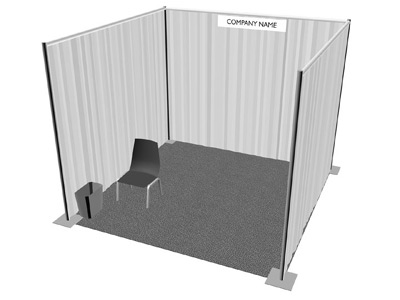
Most people dress this up by bringing in their own drapes, and/or their own furniture and accessories.
You can also use resources through NSS to design and build your booth, like Manny Stone, a company that can build virtually anything for you out of foam core. You can also rent carpet and furniture through Freeman. This is what the majority of exhibitors do, since most people are coming from other states, don’t want to store a booth for the next year, and don’t want to deal with the designing and building of the booth themselves.
Brooke, from Simple Terms, exhibited right across the aisle from us, and she used Manny Stone to build her booth and the shelves for her back wall:
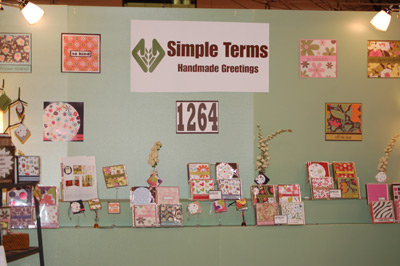
Because I worked as an interior designer before starting Sarah Marie, I was really looking forward to designing our little booth. I was also lucky that my boyfriend has a degree in technical theatre, and builds sets for Broadway shows. We had a lot of unique resources in this area of planning for the show, and we definitely took advantage of that.
I started designing the booth at the same time I was designing our line of products. I knew I wanted it to look like a small boutique, like what I would design if we had a retail space. I limited the design to three colors; teal, white, and grey. Having a focused color palette really helped to unify the space, and because we only had 80 sq. ft. to work with, this was even more important. Because we really didn’t have a lot of product, I wanted to minimize the amount of useable wall space we had in order to make it look like we had more than we did; I achieved this by putting a white wainscot on all three walls of the booth.
This is a 3d rendering I did of our booth in 3D Studio Max, a modeling program I used back in my interior design days:
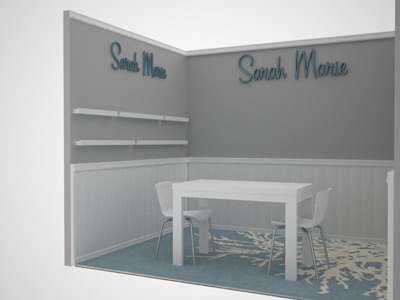
And here are pictures of the final booth:
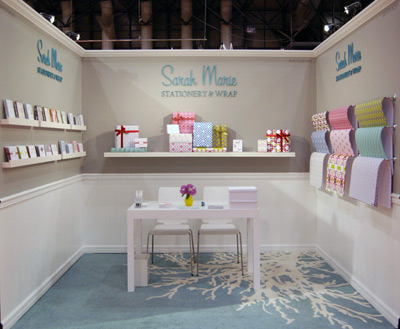
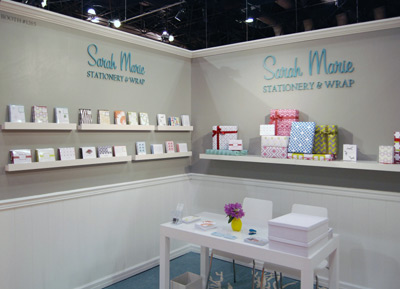
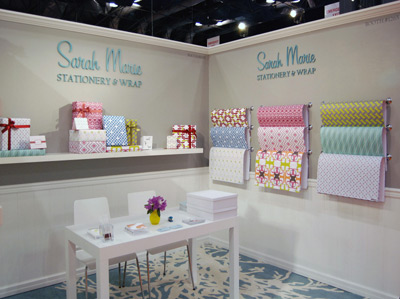
We bought the table from Overstock.com for $100. I saw a similar table at West Elm for over $300, so shopping around is definitely worth it. The rug was our most expensive purchase, around $400 from CB2, but we’re using it again next year, so the overall price is about the same as it would’ve been to rent a carpet through Freeman. All of the shelves are either from Ikea (the Lack wall shelf) or West Elm (the white picture ledge), and the wrapping paper is being displayed on towel bars from Bed, Bath, and Beyond. The chairs were also from Ikea, the Gilbert, for $50 each. We had our Sarah Marie logo laser-cut from 3/8″acrylic by Mr. Sign in New York.
Transportation & Storage
If you had a booth built for you, the setup is minimal. You just show up on your designated load-in day (typically 2-4 days before the show), and the union guys put up your booth for you. Then you have the rest of the day to put up any accessories you may have.
We brought in the components of our booth on a U-Haul truck, the union guys unloaded it and took it to our booth space, and my boyfriend and his friend put the walls up. Make sure you read your contract for the union labor rules about setup and breakdown, there are certain things you are not allowed to do, and you will get fined for breaking the rules. In general, you can’t use any power tools, or stand on a ladder or table.
Other Factors to Consider
Lighting is more important than you think, we initially did not purchase electricity for the booth because we thought the lights from the Javits Center would be enough. We realized how wrong we were during booth setup, and had to pay an extra fee for day-of setup. I highly recommend pre-purchasing electricity or one of the lighting packages through the show.
Overall
The design of the booth is very important, it’s the first impression buyers have of your brand, and it’s important for it to be consistent with your products. We were complimented numerous times on the design of our booth by both buyers and other exhibitors (so much so that I think we should start another company focusing on booth design!), and I think it’s safe to say that the clean, professional design of our booth is what lured hesitant buyers in. Looking professional and well-organized is especially important for the first-time exhibitor.
Prepping for the Show : Marketing
Once we had our greeting cards and wrapping paper in the production phase, we started focusing on marketing. The first step we took was compiling a list of stores we wanted to target with our marketing campaign. The organizers of the Stationery Show offer a list of last year’s show attendees that you can buy according to category (gift shop, stationery store, online retailer, etc.), however you don’t get a physical copy of the list. This makes sense for the show organizers, since they obviously want you to keep buying their list each year, but it didn’t make much sense for us. We wouldn’t know who our mailing was sent to, so we wouldn’t know whether or not they visited our booth, and therefore wouldn’t know how successful our campaign was in generating visits and orders.
So we, like many of the other first-time exhibitors we spoke with, compiled our own list. It seems that we all went about this in a similar way, by first listing the stores we knew and liked in our own area, then asking family and friends to recommend stores in their respective areas, and then researching what stores our competitors were in. This approach definitely takes a lot more time and effort than just buying the NSS list, but in the end you have a much more refined list of contacts.
The next step was deciding what exactly to send to this list of stores, and the quantity. We decided even though it would be a little more expensive, we needed to send a physical sample of our product to potential stores. So we chose two card designs, 150 of each, to send out. We fed all the cards through my desktop printer, and printed a little blurb about our company, our product offering, the show discount we were offering (more about that in the next post!), and of course our booth number.
The thing to keep in mind with a direct mailing is that the response rate can be anywhere from .5 to 2%, and anything above 1% is considered a successful campaign! So from the 300 cards we sent out, a response of 3-6 stores would be considered a success.
We got one order right after sending out the mailing, and one buyer made an appointment to meet with us at the show. Other than that, we didn’t get much feedback before the show, and were feeling pretty disappointed. However, after the show, we realized that 85% of the orders we received were from people who received a card, and 25% of the people who visited our booth were people who received a card. Not as bad as we thought!
We were afraid we had spent too much money on the mailing, but it definitely paid for itself through the orders and visits we received. I think the more targeted your list of contacts, and the higher the quality of your mailing, the better your response rate will be.






